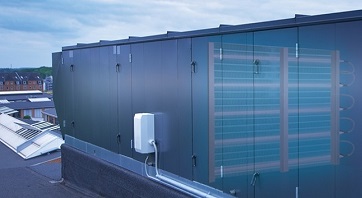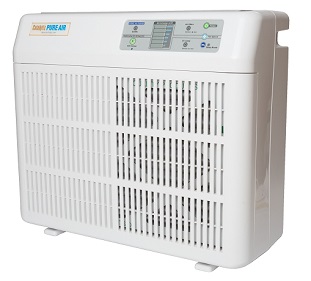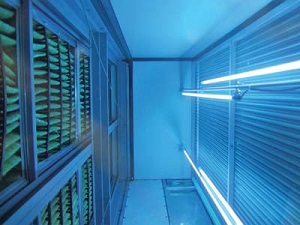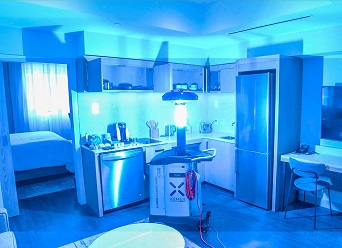
NATIONAL REPORT—Whether in fixed areas such as air handling systems or in portable devices such as air purifiers or germ-killing robots, ultraviolet (UV) radiation is being used to help combat the threat of coronavirus (COVID-19). UV radiation is present in sunlight and constitutes about 10 percent of the total electromagnetic radiation output from the sun. In manmade lamps, more highly concentrated UV rays can be highly effective at killing germs, bacteria and viruses.
UltraViolet Device, Inc. (UVDI), in a press release issued this month, says coronavirus is highly susceptible to germicidal UV irradiation. The susceptibility of coronavirus to UV rays is greater than three times compared to the influenza (common cold) virus. UVDI offers in-duct air disinfection systems for air handling systems. With its UVDI V-MAX Air Disinfection for HVAC Systems, UV lights are positioned parallel to the airstream providing optimum UV exposure within the duct. The system offers kill rates of up to 99 percent.
To ensure the proper UV dose is applied, UVDI’s proprietary software is used to model the lamp quantity and system arrangement needed for the specific application. The output of this modeling produces a very detailed report showing intensity distribution and kill rates. Factors impacting dose include: spatial constraints, airflow volume, speed, temperature, and UV device geometry and intensity.
Jim Kenney, Business Development Manager for UVDI, says the UV rays produced disable the DNA in the pathogens and then they cannot reproduce.

Portable PURE AIR Purifier
In addition to representing UVDI, Kenney runs Catalytic PURE AIR LLC. Catalytic PURE AIR offers a portable PURE AIR Purifier for guestrooms and other spaces that also incorporates UV light technology. Indoor air pollutants, bacteria and viruses are drawn to a photo-catalytic reactor grid. UV light illuminates and super-activates the reactor grid. Photo-catalytic oxidation reduces the contaminates to carbon dioxide and water.
“With the UV lamp in there we get a 70 percent reduction in viruses and bacteria,” Kenney says.
The UV lamp for germ reduction is just one of six stages in the PURE AIR Purifier. The other five stages include a 5 micron prefilter, 1st gas absorption layer, hospital grade HEPA filter, 2nd gas absorption layer, and photo catalytic converter.
Kenney says the PURE AIR Purifier is commonly used in casinos in smoking areas and in smoking rooms to eliminate the chemicals and odors from cigarette smoke.
“A lot of the housekeeping departments keep them around for guests who have an allergy or sensitivity,” Kenney says. “There is no ozone in these units. There are many applications for it. About 10 percent of the population has some type of respiratory issue.”

Even PTACs Can Use UV Technology
Another company that offers UV light disinfection for HVAC applications is Fresh-Aire UV.
“Conventional filtration is effective against particulates, like dust, but has no effect on the other two thirds,” the company says. “Fresh-Aire UV light products, such as Blue-Tube UV, are proven to sterilize biological contaminants like mold, germs, and viruses in the air and on air system surfaces. Our award-winning APCO products neutralize odor-causing VOCs as well as biological contaminants inside the air system.”
Unique to Fresh-Aire UV is its solutions for not only large air handling systems but also small HVAC systems such as mini-splits, PTACs, and fan coil units.
LightStrike Germ-Zapping Robots
Earlier this month, The Westin Houston Medical Center announced that it is the first and only hotel in the United States to utilize LightStrike Germ-Zapping Robots to sanitize and disinfect its guestrooms and common areas to help combat the threat of coronavirus.
The room disinfection technology, provided by San Antonio-based Xenex Disinfection Services, was developed by two epidemiologists in Houston, with The University of Texas MD Anderson Cancer Center as their first customer. The Westin Houston Medical Center purchased two of the decontaminating robots, which are already at work sanitizing rooms inside the building.
 LightStrike robots have been proven to quickly destroy viruses, bacteria, and fungi using intense pulsed xenon UV light.
LightStrike robots have been proven to quickly destroy viruses, bacteria, and fungi using intense pulsed xenon UV light.
“We are taking significant proactive measures, along with following CDC guidelines, to minimize risk while also keeping day-to-day business momentum,” said Archit Sanghvi, Vice President of Operations for Pearl Hospitality, the hotel’s owner and operator. “Wellness is at the core of our business and with the LightStrike technology, we saw a distinct and innovative opportunity to create a well-prepared environment for travelers within our hotel.”
The LightStrike robot uses intense germicidal UV light to disinfect rooms by quickly destroying microscopic bacteria and viruses that may be missed during the manual cleaning process. Operated by hotel staff, the robot uses pulsed xenon (a noble gas) to create intense broad-spectrum UV light, unlike older technologies that use mercury bulbs (mercury is toxic) to create continuous, single spectrum UV light.
Glenn Hasek can be reached at greenlodgingnews@gmail.com.







